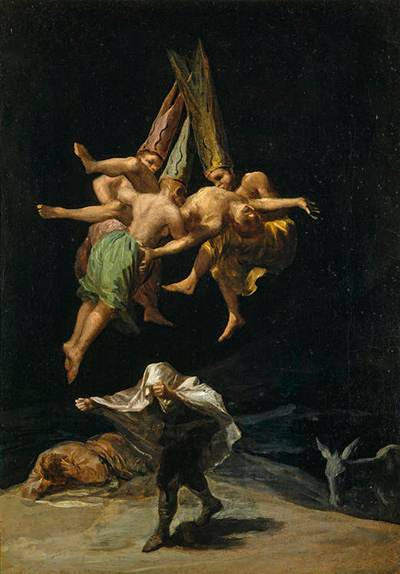Witches Flight is a painting by the Spanish artist, Francisco Goya. The title is translated from its Spanish title, Vuelo de Brujas, which has also been translated as Witches in the Air.
It is an oil on canvas painting that was completed in 1798. It measures 31.5 x 43.5 cm. Witches Flight was sold, along with five other paintings featuring witches, to the Duke and Duchess of Osuna, who lived in Madrid. The painting now hangs in the Museo del Prado in Madrid, which acquired it in 1999.
This powerful and disturbing painting shows three female witches carrying a man as they fly in the air. The man is naked and has his head thrown back and his arms outstretched, as if he is struggling. The three witches appear to be biting or kissing his body. The witches are nearly naked, as well, and wear only short skirts and a high pointed hat, called a coroza.
On the ground beneath the flying figures is a man, clothed in black, who is walking with a white cloth or sheet completely covering his head and face. Beside him, another man is lying face down on the ground with his hands covering his ears. Nearby, standing a little down a slope on the right of the painting, is a white donkey. The background of the painting is stylised and shows only a pitch back sky and completely bare ground. No stars, clouds, grass or trees are shown, and there is no horizon.
Many details that Goya included in Witches Flight are quite obscure to us, and need to be explained, but they would be instantly recognizable to Goya’s contemporaries. As an example, the pointed coroza on the witches’ heads are painted with flames that rise upwards. Coroza were part of the uniform that those accused and found guilty by the Spanish Inquisition were forced to wear.
These were painted differently, according to the sin committed and the level of penitence. Rising flames indicate that the flying witches were samarra, or those who did not repent and were condemned to burn alive at the stake. The coroza in this painting differ from standard ones, as they have two points rather than one. This makes them echo the mitres that were worn by bishops. Another hidden symbol is the way that the figure who is walking with the cloth over his head is holding his hands with two thumbs raised. This was a common gesture, called the fija, that was used to ward off the evil eye. The donkey was a widely-used symbol of ignorance.
Witches Flight has been interpreted as an attack on the power of the church, rather than a criticism of witchcraft itself. Goya’s intention may have been to show that the ‘holy’ men hunting the witches were just as bad as their victims. The naked man, who is being tortured in the name of religion, is ignored by the figures below.
These probably represent the Spanish people, who did not oppose the witch hunts and cruel punishments that the Catholic Church was carrying out in the name of religion. The figure who is warding off evil represents the blindness of superstition, as he is trying to protect himself from something he cannot see. The figure on the ground represents willful ignorance, as he is looking down at the ground and blocking the sounds of the screams from above, even though he knows what is going on. The donkey, too, does not look up but stares straight ahead as if uncaring.
This painting was one of a series of paintings with the same theme, commissioned by the Duke and Ducherss of Osuna. The others were The Witches’ Sabbath, The Witches’ Kitchen, The Stone Guest, The Devil’s Lamp and The Spell.




